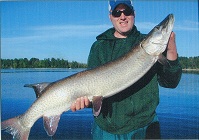|
|
Posts: 33
| Hi folks, been browsing this forum for a while, but this is my first post. I was hoping some of you guys might be able to shed some light on a question I have. In regards to blank construction, how strict are the ratings that the manufacturer has given for the rod? Example: I purchased a Quantum Lindner's Angling Edge rod a while back. I don't know much about that specific brand of rod, but the clearance price was good, so I figured I would take a gamble on it. However, the rod is only rated for up to a 2 oz lure and 40# line. The rod is 7'10", Heavy Fast. Would I be okay throwing a slightly larger lure and heavier line? I intended the rod to be for bucktails, so I don't foresee casting anything much larger than 3 oz. I realize that throwing larger lures on a rod that was intended for smaller lures will put extra strain on the blank, but how much "wiggle" room is there in these ratings? What makes this rod different than say a 7'6" heavy that is rated to throw up to a 6 oz lure? Just curious. Thanks in advance. |
|
| |
|

Posts: 1247
Location: Walker, MN | In my experience those ratings are kind of all over the map.
Welcome to M1st bud! |
|
| |
|
Posts: 33
| That's what I seem to notice. I wonder if some of it is just manufacturers protecting their warranty by giving their rods a low lure weight rating. I could be wrong. |
|
| |
|
Posts: 218
| I've talked about this a bit before. There is no standardization in the rod building business. A rod is rated by the manufacturer to whatever they think it is. Some are relatively conservative with their numbers others are very liberal. Line ratings on rods are something you can basically throw out the window because often rod builders use those line ratings based on mono rather than braid line. In todays world any musky rod builder worth their salt will build rods that can use braid of virtually any practical strength. When comparing musky rods I use St. Croix as a baseline. They probably do more research and testing of a wider range of rods than anyone. They have an amazing rod development and product engineer who has more data about what a stick of graphite will and won't do than you can believe. I think that St. Croix tends to be a tad on the conservative side with their lure ratings but they are not just stating how heavy you can go. Their ratings actually indicate the most effective range of lure sizes for that particular rod. In addition I know that the people who build and sell those rods are musky fishermen and actually have on the water time with the product before it goes to market. So for example if I know what I can and can't do with an 8' Heavy/Fast Premier I can grab any other rod from any manufacturer that is marked as an 8 Heavy and know if it's going to do what they say it will. |
|
| |
|

Posts: 4053
Location: Land of the Musky | Pete hit it on the head 
"ratings actually indicate the most effective range of lure sizes for that particular rod"
This is how most rod companies rate their rods. Example, a Tackle Industries MH rod can throw a pounder but you are loading the rod up far more than its casting ability for proper use. TI rods are rated to the optimal lure weights within the "sweet" spot of the rod. Don't look at the "power" of a rod but more at the lure ratings on the rod. LOL about the line weight ratings too. My daughter has 30lb Power Pro on her Barbie pole and I think its rated for 2lb mono 
James
|
|
| |
|

Posts: 163
Location: NoDak | Yes totally agree with ^^^ however the 2-6oz rod will only cast a 1/8oz jig 20 feet and I can throw the gig further, it's all about optimizing the benefit of the rod flicking the lure. |
|
| |
|

Posts: 908
Location: South-Central PA | Most of the time manufacturers ratings are pretty close to the 'sweet spot' of lure weights that work best for that particular blank. They serve as more of a general guideline and you'll find a few that aren't really all that accurate. Be careful overloading rods that have high strain graphite in them. They don't take the abuse as well as lower strain graphite and glass.
jeremy |
|
| |
|
Posts: 33
| Thanks for all the feedback. I figured it had something to do with using the blank for a specific technique, but I wasn't sure of the exact limitations. After doing a little more research on the Angling Edge rods, I found that they are indeed marketed as a technique specific line of rods. Either way, it shouldn't be a problem as I have other rods designated for the larger baits, so this should hopefully work well for some smaller cranks, topwaters. I guess I will find out once the ice comes off. |
|
| |
|

Posts: 1000
| Best thing you can do is go out and try it. I wouldn't be concerned about line weight, but if it doesn't feel right casting some of the lures then you may want to move up. Lots of great rods (especially TI's) for very reasonable prices. |
|
| |
|
Posts: 39
| My rod is rated for, I think, 65 lbs. line. I went up to 80lbs. as it helps prevent backlashes. No problem. Remember, the drag on your reel will let the line slip with way less than even 40 lbs. of force on it. I wonder if you could pick up a 40 lbs. weight with any rod? |
|
| |
 Rod ratings
Rod ratings Rod ratings
Rod ratings